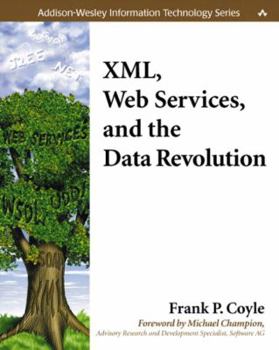XML, Web Services, and the Data Revolution
"Frank Coyle's XML,Web Services, and the Data Revolution does a great job of explaining the XML phenomenon by clearly describing where it came from, why it has proved so useful, and where it is likely... This description may be from another edition of this product.
Format:Paperback
Language:English
ISBN:0201776413
ISBN13:9780201776416
Release Date:January 2002
Publisher:Addison-Wesley Professional
Length:400 Pages
Weight:1.40 lbs.
Dimensions:1.0" x 7.3" x 9.1"
Customer Reviews
5 ratings
Picture Perfect
Published by Thriftbooks.com User , 21 years ago
If one can't manage to complete a book in a week, then it is not a book. It is a reference that you occasionally use. XML, Web Services, and the Data Revolution by Frank P. Coyle definitely comes under my 'book' category. If one wants to learn what XML and Web Services are in a week, this is a book to read. Lot of information yet concise presentation accomplished with self explanatory pictures depicting various XML technologies.
Distributed Data: Past, Present and Future
Published by Thriftbooks.com User , 21 years ago
There are about 230 pages of actual content that provide a high-level tour of what the author calls the "data revolution." There is a crisp and concise overview of the XML technology family, along with some examples of XML in use. There is broad yet concise description of SOAP and Web Services. Common implementations like .Net, J2EE and other vendor implementations are discussed along with some of the issues in the industry. XML Security is discussed in enough detail to give you a good grasp of the issues. The book wraps up with some ideas about where this technology could take us.The best thing about this book is that it shows how XML and Web Services overcome many of the problems that plagued RPCs, DCOM, CORBA and RMI in a way understandable by anyone.This book is a quick read, in the concise, bulleted, margin-annotated style of Object-oriented Technology: A Manager's Guide. There are lots of really excellent visuals. This book will not help you actually write code or implement Web Services -- it is good for a semi-technical reader, or a technical reader who wants a better grasp of the big picture. Highly recommended.
Excellent reading, straight-forward, great visuals
Published by Thriftbooks.com User , 21 years ago
Mr. Coyle has done an excellent job in demystiying XML and Web Services. He describes the technical details in a fashion that makes it easy to understand, and comprehend on the first read. His visual examples help the reader see the network, and communication paths that takes place between XML, SOAP, and WSDL. I consider myself semi-technical, and I felt that I had a much better grasp of these concepts, and the possibilities of applying this technology after reading his book. Highly recommended.
Refreshingly unbiased and gives complete picture
Published by Thriftbooks.com User , 22 years ago
In many respects this book extends David Linthicum's B2B Application Integration by focusing solely on the data aspects, and explaining the web services approach that has matured after Mr. Linthicum's book was published. This book defines the tools, cuts through the hype and sorts out the pieces needed to design and deploy enterprise-wide solutions. What makes it particularly valuable is that it doesn't side with the two major factions espousing web services - the Microsoft .NET and Sun-sponsored J2EE approaches are presented without bias (refreshing in itself considering the hype and industry posturing). The same objective treatment of approaches by IBM, BEA, HP Oracle is given, which ensures that you have ample insights into the available approaches to developing web services. Of course, SOAP, the XML-family of protocols, and UDDI are also covered in depth using clear writing and excellent illustrations.What I particularly like about this book are: - the way Chapter 1, Extending the Enterprise, presents a coherent picture of the complexities of web services and enterprise integration. This is done in less than 30 pages and packs an amazing amount of information into those pages.- Chapters 3 (XML in Practice), 4 (SOAP) and 5 (Web Services) drill down into the guts and sort out the complexities - especially the discussion of web services, which doesn't [yet] seem to have a standard definition.- Chapter 7's discussion of XML security, which is a nice and needed touch that rounds out the information provided in the book.You won't find specific development information in this book, and that makes it more valuable in my opinion. If that is what you're seeking there are other books that address that topic. I do believe that Linthicum's B2B Application Integration and William L. Oellermann's Architecting Web Services will complement this book - Linthicum's for the big picture (especially for legacy system integration) and Oellermann's for the process-oriented approach. I strongly recommend this book to anyone who is involved in architecture, specifications or development.
XML, Web services and the Data Revolution
Published by Thriftbooks.com User , 22 years ago
In a relatively short time XML has become the Lingua Franca in web based development for its ability to provide clean, powerful cross platform language that learns from and corrects the mistake of its predecessors. With such a quick rise there is an inherent need educate people on the subject. XML, Web Services and the Data Revolution is that rare book that communicates to both IT professionals and business executives. Frank gives an excellent overview of the history of XML and the coming of Web services. Frank also takes a proactive look by addressing the security concerns of XML - a subject all to often avoid until a major breach is exposed or a hack makes the cover of the NY Times or the hottest IT publication of the day.Don't let the data revolution pass you by - educate yourself with XML, Web Services and the Data Revolution.




